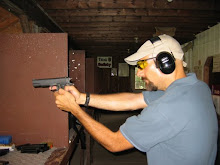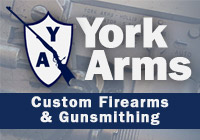It was also an industry first – the first polymer-framed revolver. Smith & Wesson has been using lightweight metal frames, including their unobtainium super lightweight scandium and titanium models, to lessen the weight of their small, concealable revolvers. Ruger opted to use a polymer grip frame with an aluminum housing around a stainless cylinder and a sleeved barrel to save weight, bringing the LCR to an ultra-light weight of only 13.0 ounces, only a single ounce heavier than the Smith & Wesson scandium models.
The good folks at Sturm, Ruger, & Co. were kind enough to send MArooned an LCR for Testing and Evaluation. Over the course of a few months I’ve had plenty of opportunity to shoot and carry the LCR and will offer my thoughts on both. I’ve carried a short barreled revolver for years – including the Snubbie from Hell™ - and figure I have a decent background for checking out the LCR.
LCR and related
The LCR comes in a cardboard box with a small nylon pouch, and not much else. MSRP from Ruger is $525 - $75 more than the MSRP for a comparable Smith & Wesson model 642 – however the “off the shelf” price at my local gun store has the two within $10 (LCR at $370, 642 at $360). It’s a five-shot, double action only, polymer-framed revolver tipping the scales at 13.5 ounces empty. The frame is quite interesting:
When Aluminum Met Polymer
You can clearly see the line between the polymer grip area and the aluminum chassis for the cylinder and barrel. The cylinder is also a little different:
Funky!
It’s partially fluted to save weight, with a good chunk of the cylinder shaved off, yet still robust enough for .38 Special +P ammunition. Ruger did their homework on the LCR – while it retains the legendary Ruger “built like a tank” history, it – unlike the SP101 – does not weigh as much as a tank, and is therefore very well suited for a daily carry firearm.
Carrying the LCR
The LCR is very close in size to the Smith & Wesson J-frame, so most holsters that fit the S&W will also work for the LCR:
FlatJack
That’s a Dragon Leatherworks FlatJack holster designed for the S&W J-frame.
Exec II
That’s a Michael’s Custom Holsters Executive II holster designed for the S&W J-frame.
Unknown vintage
That’s a generic nylon holster designed for the S&W J-frame.
And the only one that didn’t work:
Nemesis
That’s a DeSantis Nemesis designed for the S&W J-frame. The LCR will fit into the Nemesis, but it’s quite snug and less-than-ideal for drawing from a pocket.
The LCR is lightweight, small in size, and carries very well. It’s certainly something that you can tote around for the better part of the day and not even notice – it’s less than a pound fully loaded. It fits inside a pocket or disappears in the waistband with minimal cover garment needed. It’s a tight fit inside a pair of jeans, but that’s par for the course with a revolver of any size greater than the NAA Mini-22. I’ve carried a Smith & Wesson J-frame revolver for nearly 20 years, and the LCR is indistinguishable in how it can be carried. If you can carry a J-frame, you can carry the LCR.
The only issue I had was that the Hogue Tamer grips – which did a decent job on the recoil – are pretty chunky for a revolver you want to stick in your pocket. I talked to the guys at Hogue at SHOT Show in January as to whether they were going to offer a “bantam” style grip for the LCR, and they said that wasn’t in the works. The design of the Ruger LCR grip, shown here:
Get a grip
means that there’s not a lot of size that can be shaved off the grip – the grip frame is the same size as the frame of the LCR itself. Any grip made is going to by design be thicker than the frame of the gun, and with the point of attachment being the very bottom of the grip, making a boot grip-style stock for the LCR will be problematic as well. There is a Crimson Trace grip laser available for the LCR, either as a factory option or separately from Crimson Trace.
Shooting the LCR
There’s really not much surprising to say about shooting the LCR. It’s a lightweight, double action only revolver – there’s a bit of a kick to it; the trigger pull is long by design; the sight radius is tiny; and the rear “sight” is a groove carved into the top strap. The gun itself is quite accurate – it is a Ruger after all – but it does require a significant investment of time and effort to be able to shoot it accurately at greater than "close-talker" distances.
I’ve always been of the “good enough” mindset for carry guns – if I can shoot it quickly and hit the black on a standard silhouette target at 25 feet, I’m satisfied. The LCR is more than capable of this sort of accuracy:
Passable
That’s an NRA B-29 target shot at 25 feet, two cylinders (top is .38 Special +P 147 grain Federal JSP; bottom is .38 Special 158 grain Winchester White Box). I’ve put a fair amount of time in shooting J-frames, so I had a notion of what to expect, but I’d imagine that anyone willing to invest a little time in learning to shoot it – and dry firing a mess of times – could achieve similar results. The trigger right out of the box was very good for a DAO revolver – I still suggest dry firing to smooth it out, but it is pretty darn good off the bat.
The recoil is, well, noticeable. Shooting .38 Special +P through the LCR will get your attention – now, not quite like a 125 grain .357 Magnum, of course, but you will feel it. The Hogue Tamer grips do a great job of helping with the recoil, and I agree with my esteemed colleague Weerdbeard that the polymer frame helps absorb some of the recoil better than a metal frame. But it’s still not a gun that most will want to shoot extensively at a single range outing – but, unlike my lightweight Smiths, it never cut my trigger finger…
Conclusion
When the LCR was introduced, I will admit that I scoffed at the concept. A polymer revolver? It just seemed so wrong, especially where Smith & Wesson's Airweight series is extremely similar in size, weight, and price. It didn't appear that the polymer frame really gained all that much over a lightweight steel allow; and to be honest, it's really just personal preference (although the polymer is easier to clean, a definite plus for me).
Now, though, after carrying and shooting the LCR for several months, I have to admit that the polymer frame is a viable, plausible, usable option. It's still got a stout recoil - but that's to be expected in a small, light gun firing a "standard" caliber. It's hard to shoot accurately - but that's also to be expected given the short sight radius. The gun has no failings of its own; it shot everything I put into it and would have been happy for more - again, it is a Ruger, after all. It's a reliable platform that will most likely outlast the person purchasing it.
With Ruger's new LCR, the snubnose revolver enters the 21st century in a big way.
That is all.











2 comments:
Jay,
I own and carry an LCR on a regular basis. They do make a bantam style grip for it. Its available from Ruger's website http://shopruger.com/Hogue-LCR-Bantam_Boot-Grip/productinfo/19927/ (currently sold out!)
It makes it much easier to carry, since the sides are smooth plastic, preventing it from catching on your cover garment. It still has the Hogue tamer pad on the back where the webbing of your hand takes the recoil. It shoots about the same as the stock grips, but there is less to hang on to.
-Mark
"unobtanium"? Is that anything like Wonderflonium? (And what happens when you bounce it?)
Post a Comment